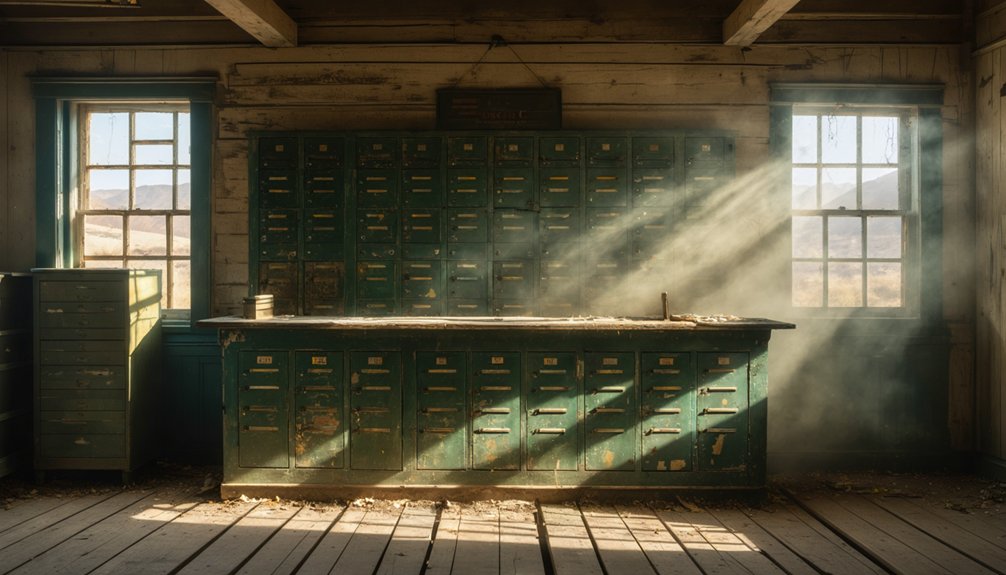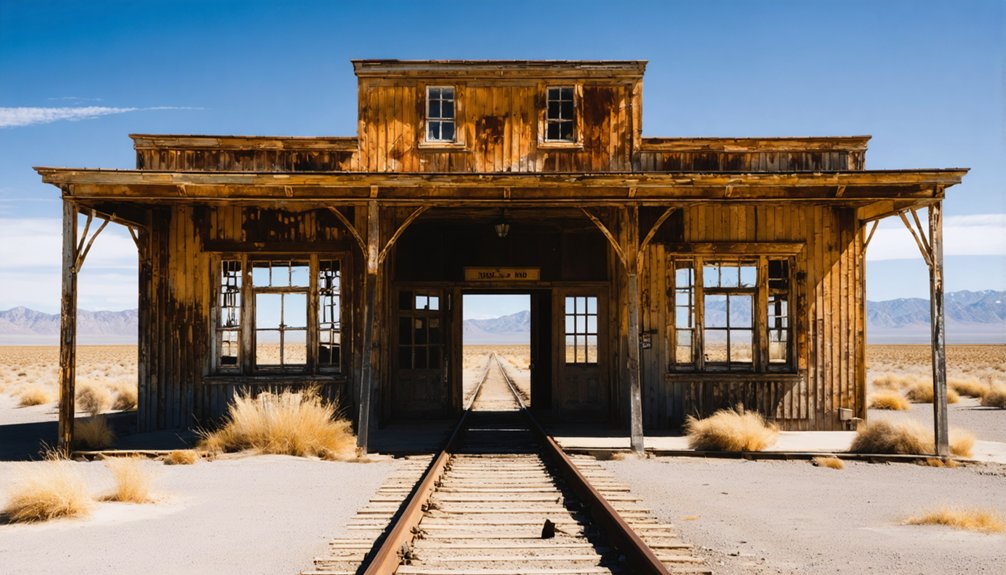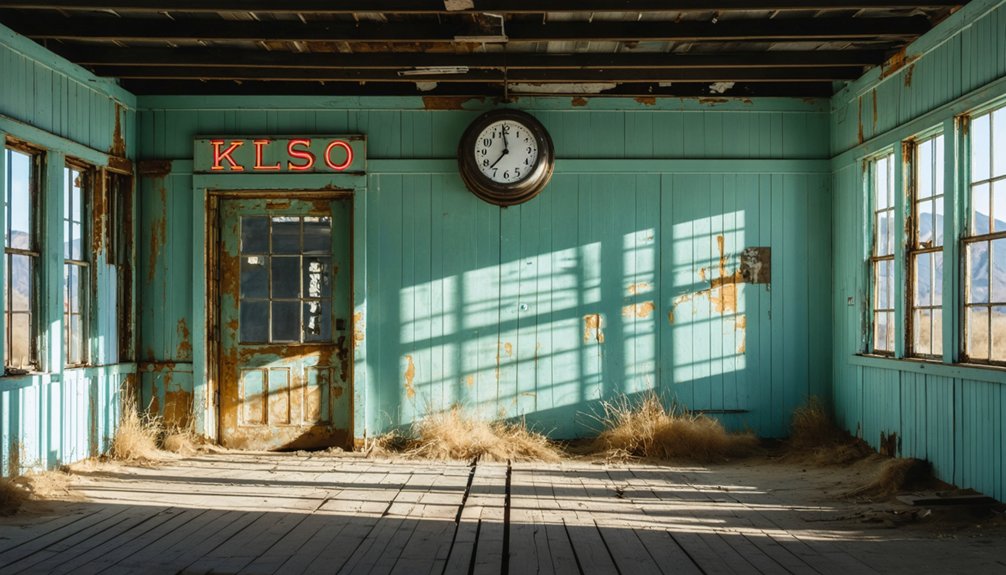You won’t find Kelso, Texas on modern maps because it never truly existed. In 1907, con man George G. Wright created an elaborate phantom town on 80,000 acres of XIT Ranch land, complete with fake storefronts, hired actors, and a temporary post office. He duped investors into buying parcels at $8-40 per acre through carefully orchestrated visits and deceptive marketing. The tale of this theatrical frontier swindle reveals one of America’s most audacious land schemes.
Key Takeaways
- Kelso was an elaborate land fraud scheme in 1907 where George G. Wright created a fake town to sell 80,000 acres of XIT Ranch land.
- The phantom settlement featured staged buildings, hired actors, and imported crops to convince potential buyers of its authenticity.
- A temporary post office operated from 1907-1908, providing the only legitimate federal presence in the fraudulent settlement.
- The town existed purely on paper, with no genuine residents or commerce, selling land parcels for $8-40 per acre.
- Kelso became known as the “town that never was” after the scheme ended, leaving only empty prairie and a cautionary tale.
The Birth of a Phantom Settlement
Three distinct elements marked the peculiar birth of Kelso, Texas: deception, theatrical flair, and ambitious land fraud.
In the early 1900s, George G. Wright orchestrated one of Texas’s most elaborate phantom settlements, transforming 80,000 acres of XIT Ranch land into a staged spectacle of frontier opportunity. Like many places sharing the name, this Kelso required careful disambiguation efforts to distinguish it from other locations bearing the same title. Much like the California Kelso, which got its name when railroad workers put their names in a hat, this Texas town’s naming had its own peculiar story.
You’d have found Wright’s masterpiece of land speculation about 25 miles northwest of Hereford, where he’d constructed a convincing facade of civilization. His fake town boasted a hotel, general store, schoolhouse, and barn – all staffed by actors playing their parts to perfection.
A brazen theatrical deception rose from Texas plains – a phantom town where hired actors convinced buyers they’d found frontier gold.
He’d even shipped corn from Iowa to fill the barn, while hired performers kept the store looking busy. Special trains brought potential buyers from Kansas City, carefully isolated from locals who might’ve exposed the truth behind this carefully crafted mirage.
Mastermind Behind the Deception
While many land schemers operated in early 1900s Texas, none matched George G. Wright’s audacious vision and meticulous execution.
In 1907, he orchestrated an elaborate confidence scheme using 80,000 acres of XIT Ranch land, transforming it into a phantom settlement that’d fool even the shrewdest investors. Much like how Bill Ivy’s vision transformed Terlingua’s preservation efforts decades later, Wright had grand plans for his ghost town project. Similar to how Rey Winkleman moved historic buildings to create a tourist village, Wright carefully crafted his illusion of a thriving town.
Wright’s deception techniques were masterful. He built fake storefronts, hired actors to portray busy townspeople, and even imported corn from Iowa to create the illusion of agricultural success.
You wouldn’t have spotted the fraud easily – he controlled every detail, from chartering special trains to isolating prospective buyers from locals who might expose the truth.
Setting the Stage: Building a False Reality
Wright’s calculated deception required a fully immersive stage set, and he spared no detail in crafting Kelso’s physical facade. His architectural deception transformed empty Texas plains into what appeared to be a thriving frontier town, complete with a hotel, general store, and schoolhouse.
The illusion creation extended beyond mere buildings, encompassing every aspect of small-town life. Just like the real Mojave National Preserve location, the town featured a prominent train depot at its center. The depot contained telegraph offices like genuine railway stations of that era.
- Hired actors posed as residents, maintaining the facade of daily commerce and community life.
- The general store’s shelves were meticulously restocked after each group of visitors departed.
- Iowa corn filled the massive barn, suggesting agricultural prosperity.
- A temporary post office operated from 1907-1908, lending legitimacy to the scheme.
You’d never have known the town was hollow – each structure carefully designed to convince potential buyers they were investing in a genuine community.
The Art of the Land Sale Scheme
You’d hardly believe the audacious way George G. Wright orchestrated his land swindle, using a meticulously staged ghost town to convince buyers they were investing in prime Texas farmland at $8-40 per acre.
Wright’s team employed actors posing as townspeople, stocked false storefronts with temporary merchandise, and controlled every aspect of prospective buyers’ visits via special trains from Kansas City to maintain the illusion.
The scheme succeeded in selling all 80,000 acres by carefully isolating buyers from local residents who might expose the truth about the land’s poor farming conditions and the need for deep-well irrigation.
Much like the decline of Belle Plain after losing its county seat status, Kelso’s fabricated prosperity was destined to be short-lived.
The ghost town’s post office operated for just a brief period from 1907 to 1908, highlighting the temporary nature of this fraudulent settlement.
Staged Town For Profit
In what stands as one of Texas’s most brazen real estate scams, the staged town of Kelso emerged as a masterpiece of deception in early 1907.
This urban illusion, sprawling across 80,000 acres of XIT Ranch land, wasn’t just any ghost town – it was a fabricated community designed purely to dupe unsuspecting land buyers.
- You’d find a fully-stocked general store where actors posed as customers, purchasing goods that were immediately restocked.
- The hotel exclusively hosted prospective buyers, creating an illusion of bustling activity.
- A pristine schoolhouse stood ready, never to hold a single class.
- A massive barn filled with imported corn completed the façade of agricultural prosperity.
Like many rural Texas towns facing declining populations today, the entire operation ran with clockwork precision, keeping buyers isolated from locals who might expose the truth about this elaborate charade.
Deceptive Marketing Tactics Used
The deceptive marketing tactics behind Kelso’s elaborate stage show demonstrated remarkable sophistication for 1907.
Through misleading advertisements, promoters pitched worthless parcels at $8-40 per acre by concealing the land’s true remote location and poor farming conditions. You’d have been told the soil was perfect for dryland farming, when in reality, it required expensive deep-well irrigation to yield anything.
The scheme’s buyer manipulation went beyond false claims. You wouldn’t meet any locals during your visit – they were kept away while paid actors created an illusion of prosperity. Similar to the modern example of Lobo, Texas being sold for just $100,000 today, these ghost towns often come with surprisingly low price tags.
The carefully orchestrated experience included a staged general store, fake customers, and imported corn displays. Even the train journey from Kansas City was controlled to prevent you from discovering the truth about this manufactured town’s empty promises.
Anatomy Of A Swindle
While fraudulent land schemes were common in early 1900s Texas, George G. Wright’s operation in Kelso stands out as a masterpiece of deception.
He understood buyer psychology perfectly, creating an elaborate façade that played into settlers’ dreams of prosperity. His fraudulent infrastructure wasn’t just buildings – it was a carefully choreographed performance designed to separate you from your money.
- You’d arrive by special train, carefully isolated from locals who might spoil the illusion.
- You’d tour a bustling town complete with actors posing as residents and merchants.
- You’d see corn-filled barns shipped from Iowa, suggesting rich farming potential.
- You’d witness a functioning post office that legitimized the whole operation.
Wright’s genius lay in controlling every aspect of the buyer’s experience, leaving no room for doubt until after the sale was complete.
Life in a Town That Never Was
Since Kelso existed purely on paper, you’d find no bustling streets, no neighborly gatherings, and no daily commerce typical of early 1900s Texas settlements.
Unlike genuine frontier towns where you might’ve witnessed cowboys tying their horses outside the general store or farmers haggling over grain prices, this imaginary community never saw a single resident stake their claim.
While other Texas towns of the era hummed with the sounds of railroad whistles and church bells, Kelso remained eerily silent.
George G. Wright’s false promises of a thriving municipality yielded nothing but empty prairie grass waving in the Deaf Smith County wind.
You wouldn’t have found a single homestead, shop, or schoolhouse – just vacant land waiting for unsuspecting buyers who’d purchased shares in a town that existed only in elaborate sales pitches.
The Short-Lived Postal Service Era

You’ll find Kelso’s postal history remarkably brief, with service beginning in 1907 as part of George G. Wright’s ambitious town development scheme.
The post office operated for just one year, joining other short-lived Texas Panhandle postal stations that marked speculative boom towns of the era.
When Kelso’s post office closed its doors in 1908, it confirmed what many suspected – Wright’s dream of a thriving settlement had failed to materialize.
Postal Operations Begin 1907
In 1907, postal operations began in Kelso as part of George G. Wright‘s elaborate scheme to create a community illusion on former XIT Ranch land. The postal service establishment served as a vital government endorsement, making Wright’s fraudulent town appear legitimate to unsuspecting land buyers.
- You’d find the post office situated 25 miles northwest of Hereford, strategically placed within Wright’s carefully orchestrated 80,000-acre development.
- The facility became the only official federal presence in the fake settlement.
- Wright used chartered trains to keep potential buyers isolated from local residents who might expose the truth.
- Land parcels were marketed between $8 to $40 per acre, with the post office’s presence lending credibility to the sales.
The postal service would operate until 1908, when the elaborate deception finally unraveled.
Rapid Service Closure 1908
After Wright’s elaborate deception crumbled in 1908, Kelso’s postal operations met an abrupt end, lasting barely a year from their 1907 establishment.
You’ll find it telling that the postal service’s closure coincided perfectly with the exposure of Wright’s staged town scheme, where hired actors had created an illusion of bustling community viability.
The post office’s demise reflected harsh realities on the ground: no permanent settlers occupied the properties, rail connections never materialized, and the promised agricultural development remained a mirage.
Without genuine residents or legitimate mail volume, postal authorities quickly shuttered operations.
The closure marked a final nail in Kelso’s coffin, officially confirming what land buyers had discovered – they’d invested in nothing more than an elaborate façade destined for ghost town status.
From Empty Promise to Empty Prairie
While many Texas ghost towns emerged from genuine settlements that later declined, Kelso stands apart as a town that never truly existed. You won’t find abandoned buildings or crumbling ruins here – just empty prairie land that remains much as it did when Kansas City promoter George G. Wright attempted to sell his imaginary infrastructure to unsuspecting buyers in the early 1900s.
This fictitious community’s legacy lives on through:
- Historical records marking it as a “town that never was”
- Brief appearances of a post office that served no real population
- Maps showing a location where no genuine settlement took root
- Stories of failed land schemes that left the prairie untouched
Unlike authentic ghost towns born from mining or railroad booms, Kelso serves as a cautionary tale of western speculation gone wrong.
Legacy of a Deliberate Ghost Town

Through careful orchestration of fake buildings, hired actors, and staged commerce, George G. Wright created more than just another ghost town – he established a lasting example of early 20th-century real estate fraud.
You’ll find Kelso’s historical significance woven into Texas lore as a cautionary tale of deception and failed dreams.
While no physical structures remain, Kelso’s story lives on in historical records and local narratives, teaching valuable lessons about due diligence in land purchases.
The ghost town’s unique status as a deliberately planned scam, rather than a naturally declining settlement, offers researchers and historians insight into the darker side of Western expansion.
Today, Kelso serves as a powerful reminder of how seemingly legitimate infrastructure – from post offices to general stores – could be manipulated to deceive hopeful settlers.
Frequently Asked Questions
Are There Any Remaining Structures or Ruins at the Kelso Site Today?
You won’t find any remaining buildings at the site today. Unlike other historically significant Texas ghost towns, Kelso’s fraudulent origins left no lasting structures – everything vanished shortly after the 1900s scam ended.
Did Any of Wright’s Victims Pursue Legal Action Against Him?
Though you’d expect outraged victims to flood the courts, there’s no record of legal repercussions or victim testimonies against Wright. The complex nature of early 1900s fraud cases likely deterred any lawsuits.
What Happened to the Actors Who Participated in the Scam?
You won’t find clear records of actor consequences after the scam involvement ended. They likely scattered and resumed their previous lives, while Wright faced the main legal scrutiny.
How Much Money Did George G. Wright Make From This Scheme?
You can’t pinpoint Wright’s profits exactly, but given land sales between $640,000 and $3.2 million, minus expenses for fake buildings and actors, his financial schemes likely netted him hundreds of thousands.
Were Similar Land Scams Common in Early 20TH Century Texas?
You’d find land speculation and fraud were rampant across Texas in the early 1900s, with speculators manipulating titles, forging documents, and exploiting unlocated land certificates to swindle both settlers and investors.
References
- https://en.wikipedia.org/wiki/Kelso
- https://www.atlasobscura.com/places/kelso-ghost-town
- https://www.youtube.com/watch?v=j1vcl01ulo8
- https://www.hmdb.org/m.asp?m=155119
- https://en.wikipedia.org/wiki/List_of_ghost_towns_in_Texas
- https://www.loquis.com/en/loquis/6722727/Kelso+Texas
- https://legendsofkansas.com/morris-county-extinct-towns/
- https://www.vvdailypress.com/story/lifestyle/travel/2020/12/27/beyers-byways-kelso-mojave-national-preserve-not-ghost-town/4035535001/
- https://www.youtube.com/watch?v=RHSDilzQd8s
- https://www.pacific-hwy.net/kelso.htm



